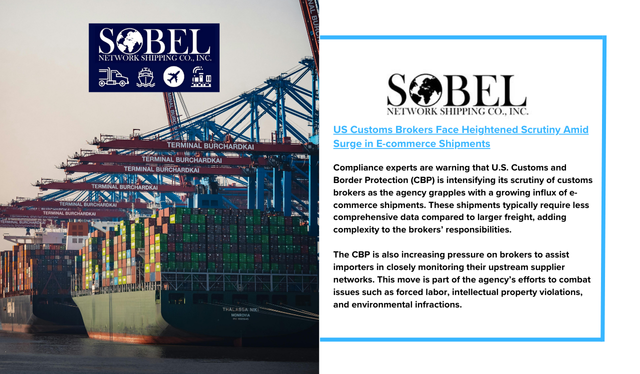Compliance experts are warning that U.S. Customs and Border Protection (CBP) is intensifying its scrutiny of customs brokers as the agency grapples with a growing influx of e-commerce shipments. These shipments typically require less comprehensive data compared to larger freight, adding complexity to the brokers’ responsibilities.
The CBP is also increasing pressure on brokers to assist importers in closely monitoring their upstream supplier networks. This move is part of the agency’s efforts to combat issues such as forced labor, intellectual property violations, and environmental infractions.
“CBP seems to expect customs brokers to have deeper knowledge about their importer clients, their products, and the admissibility of merchandise beyond traditional filing requirements,” said Cindy Allen, CEO of compliance consultancy Trade Force Multiplier and a former executive at FedEx and DHL. “This represents a higher level of involvement with importers that brokers haven’t typically faced, presenting new challenges for both brokers and their clients.”
Ania Wierzbowska-Fuller, director of consulting and regulatory affairs at customs broker AN Deringer, noted that a March advisory from CBP suggests that new regulations may soon require brokers to verify an importer’s identity, with a potential rule release as early as November.
“This is just the beginning,” Wierzbowska-Fuller said. “Brokers have always been concerned about an importer’s identity for various reasons, but it will soon be a legal requirement. As brokers, we must inform our customers—the importers—about their obligation to know their business partners.”
Brokers as CBP’s Eyes and Ears
Margie Shapiro, CEO of customs broker Shapiro, emphasized that while CBP values the role of brokers, the agency’s expectation is not for brokers to have increased knowledge about their customers. Instead, CBP wants brokers to help educate and ensure their customers understand and comply with CBP’s requirements.
Shapiro pointed out that CBP has a system in place to collect data for detecting issues like forced labor, intellectual property infringements, and non-compliance with partner government agencies. However, she noted that CBP is not adequately resourced to handle the surge in shipments under the de minimis provision, which allows for duty-free shipments valued under $800 per day per consignee.
“Our country has created this enormous loophole,” Shapiro said. “It would be highly effective if Congress could address it.”
Customs brokers have long criticized the high U.S. de minimis level, arguing that it increases the country’s exposure to risks, given that brokers serve as a critical layer of intelligence for the importing community.
Legislative Action on the Horizon
In response, five bills have been introduced in Congress since March to limit the use of de minimis. According to a CBP dashboard tracking de minimis shipments, the first half of 2024 saw as many such shipments—1 billion—as the entirety of 2023.
Trade compliance experts believe that the rising expectations for brokers and the influx of smaller shipments are interrelated issues.
“Overwhelmed by the volume and speed of shipments, customs authorities are increasingly delegating oversight and enforcement responsibilities to the trade community,” said Amy Morgan, vice president and head of trade compliance at software vendor Altana. “We’re seeing this in the promotion of more advanced information-sharing programs that encourage joint management of trade compliance between regulators and the trade community.”
Morgan added that CBP’s scrutiny of customs brokers is intensifying across all entry types, but the focus on “Type 86” shipments—de minimis shipments with limited data submissions—has become particularly sharp.
“Normal customs entries require rigorous and detailed compliance checks due to their higher value and complexity,” Morgan explained. “Type 86 entries, however, are now being closely monitored for abuse and security risks, necessitating an unprecedented level of detail about the products, including precise descriptions, product classification, valuation, origin, and full disclosure of all parties involved in the transaction.”
Morgan highlighted a recent action by CBP to suspend several customs brokers from the Entry Type 86 Test program after determining that their entries posed unacceptable compliance risks.
Navigating ‘Reasonable Care’ Uncertainty
Allen pointed out that Type 86 shipments present a significant challenge for brokers in meeting the “reasonable care” standard typically applied to importers of record.
“A customs broker is extremely challenged in meeting the reasonable care standard for de minimis entries because they rely on the information provided by their clients,” Allen said. “There is limited visibility into the depth of information required.”
“In a typical entry scenario, customs brokers can choose whether they want to serve as the importer of record, and most do not,” she added. “The owner, purchaser, or consignee usually serves as the importer of record.”
For Type 86 shipments, the information flow has been limited to what the broker needs to file the entry.
“Brokers may need to develop additional communication channels if they are expected to be more involved in the transactions and merchandise being imported,” Allen said. “This is a shift that brokers are not necessarily comfortable with, and it has also raised concerns within the importing community.”
Wierzbowska-Fuller echoed this sentiment, stating, “With Entry Type 86, we are getting less data but facing more responsibility. This is disruptive for everyone in the supply chain, including customs, which is struggling to keep up.”


